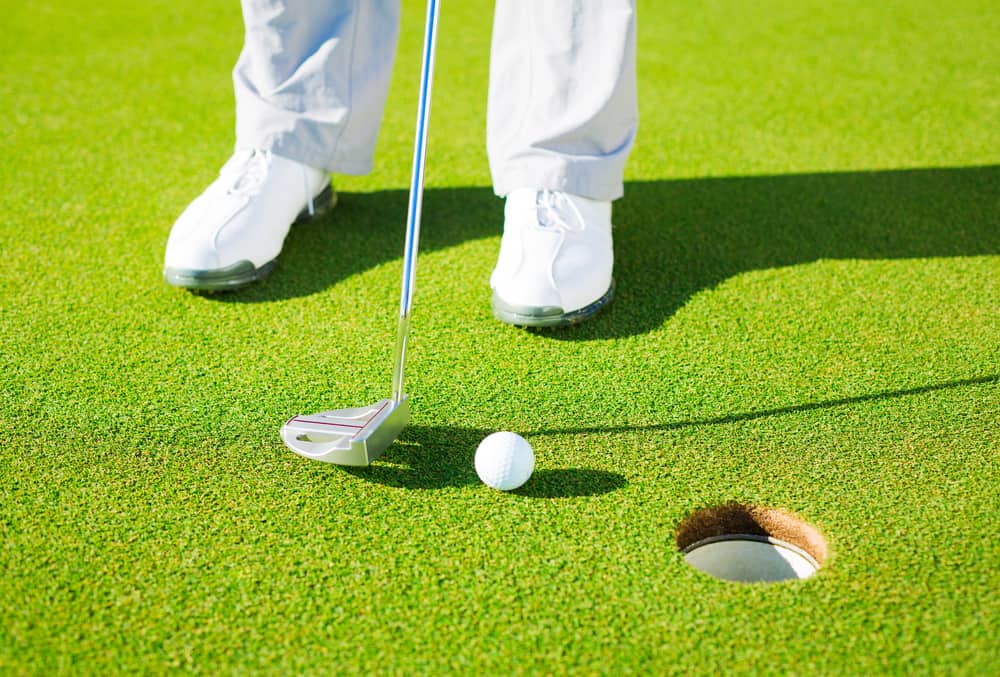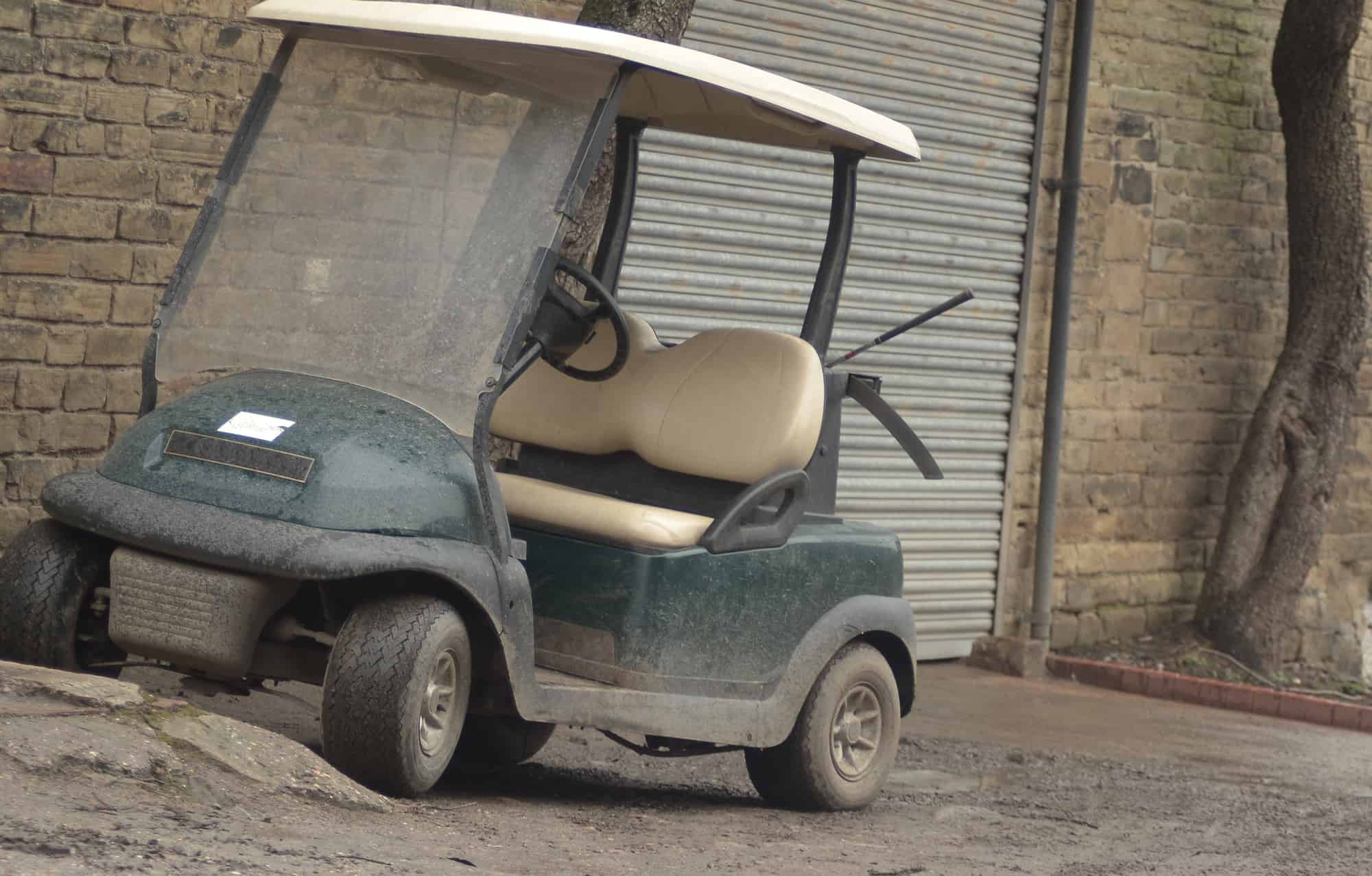
There are many debates in golf which continue to happen year after year.
Even when you have had your putter in your bag for quite some time, you will still have that lingering idea of whether a mallet or a blade is a good choice.
As the years go on and more and more putters hit the market, the mallet style seems to take over.
Let’s take a look at the differences between a blade and a mallet and which is going to make the most sense for your golf game.
Mallet vs. Blade Putter—Which Is Better for Your Game?
Mallet Putter Overview

A mallet golf putter was traditionally considered a semi-circular club head with a large sweet spot.
Where the blade looked like a small rectangle on the end of the shaft, the mallet took on a larger shape.
The mallet style putters are continuing to grow in size as they get a bit more non-traditional.
The mallet putter is no longer just a semi-circle shape.
As the putter world started to change, so did the shape of the mallet.
Now the market is filled with non-traditional mallet shaped putters, yet they are still considered to be mallets.
A non-traditional mallet is going to be one which extends past the back of the club head more so than the blade putter.
When you see all of these larger designs like the Spider Putter, they are technically still mallet putters, just much larger than standard.
A mallet putter is typically going to be more forgiving than a blade-style putter, and this has a lot to do with its shape and weight distribution.
By nature, the mallet putter is quite a bit larger, and therefore, the sweet spot tends to be a bit bigger.
If you didn’t think the sweet spot on a putter makes a difference in your game, think again.
The sweet spot is a large reason many golfers are not that good on the greens.
When you miss the center of the club face, the putter will twist or turn and cause a ball to come off the face in the wrong way.
When a beginner takes up the game of golf, many of the good beginner golf sets will come with a mallet putter.
This is often because learning how to hit a mallet and control the distance is sometimes a bit easier.
Another great thing about the mallet is that they can be very easy to align.
When you look down at the size of a blade putter, you will see that it only has a small alignment line.
The mallet has much longer, extended lines, and sometimes an entire mallet alignment system is in place.
Although the mallet putter has all of these great features for the higher handicap player, there are still some lower handicappers who love this option.
After all, who couldn’t use a little extra forgiveness and help on the greens?
Pros
- Great for the higher handicapper
- Can get the mallet in a number of different styles
- If you swing straight back and straight through, this is a great putter style
- Possibilities are endless when it comes to customization, shaft options, and more
- Perfect choice if you struggle with alignment
Cons
- Can be a bit clunky to look at
- Not the best choice with a very fast green
- Hard to manipulate club head for golfers with arc-style strokes
Blade Putter Overview

The other option on the market is the blade putter.
A blade putter is undoubtedly the more traditional putter out there and one that really stems from the early days of golf.
A blade putter is a simplistic design.
You will see that it looks very much like a rectangular putter with a small and shallow face, and it is usually heel shafted.
The blade putter was originally something you could use whether you were a righty or a lefty, but those types of putters have been phased out a bit.
The blade putter is typically known as being the player’s putter, mostly because of the classic design it offers.
A blade putter is typically a bit lighter than the mallet, which makes it a better option for very fast greens.
When you can barely tap the ball on a fast downhill putt, you don’t need the extra weight of the mallet to be hitting the ball.
The blade putter is a perfect option for those who have an arc stroke.
The design of the putter head allows it to be opened and then squared again as you get into the impact position.
You will notice that the blade putter has a tremendous feel and control and stays very consistent.
If you are a player who swings straight back and straight through, the blade will also work for your swing, but it is not as highly preferred as the mallet.
The blade styles are all much more like each other than the mallet styles.
Something like a Scotty Cameron blade putter will never go out of style, and it will remain as the top technology for years to come.
In fact, the overall technology on a blade putter tends to stay more consistent, year after year, than any other putter on the market.
One of the things we like best about the blade design is that it offers quite a bit of precision.
If you are serious about your golf game and you want to calculate and make sure your shots are always the same, this is the putter to choose.
You will notice that the putts stay on track, and they will be more consistent as you get into the impact position.
The only real problem you will have with the blade putter is that it will not be quite as forgiving.
Since the blade putter is smaller in size, the sweet spot is a bit smaller than that of a mallet.
Once your stroke is consistent and you feel good about your abilities, you should have no issues using a blade putter.
Pros
- Great for lower handicap players
- Works well on fast greens
- Very consistent at impact
Cons
- Alignment is a bit more difficult
- A smaller sweet spot can mean less forgiveness
- Not as many options on the market as the mallet putter
What Type of Putter Should Each Handicap Play?

Some people will choose a putter based completely on their handicap.
Truly, it is best to try out some putters and decide which feels the best for you and your stroke.
However, if you want to base your choice of putter on your handicap, here are a few guidelines you should follow.
1. Low
Low handicap golfers tend to play golf courses which have very fast greens.
For this reason alone, the better choice may be a blade putter.
If you watch professional golf on the television, you will notice that many of the golfers have started using blades.
As the technology of the mallet putter has changed through the years and the weighting has improved, some are switching to mallets.
For instance, the TaylorMade Spider putter is one of the highest performing on the PGA Tour.
Although this is a mallet type design, players are feeling as though the performance beats most of the blades on the market.
Generally speaking, the lower handicap golfers are going to want to play with a blade style putter to get the performance they need.
2. Average
A golfer with an average handicap can choose any type of putter they want.
The best way to pick a putter in this price range is to consider the type of stroke you have.
If you swing straight back and straight through, the mallet putter is the best choice.
When you know the type of stroke you have, you can find a much better option for your game.
Average golfers should also choose a putter which is going to fit within their price range.
It is important for average golfers to consider where they are headed with their game as well.
If your golf game is improving fast and you think you have a chance to move from an average to a low handicapper, you may want to consider switching to a blade.
3. High
High handicappers are almost always better off choosing a mallet putter.
A mallet putter is larger and easier to line up, and the distance control is also easier with a mallet design.
When a new player starts playing the game, alignment can be one of the most difficult concepts to master.
For a high handicapper, the long lines on the mallet are going to help get the ball rolling along the right path.
Many beginner sets are going to come with a mallet putter, and this is a great choice.
Even though many of these high-end alternative mallet putters cost several hundred dollars, this is probably not necessary for a new golfer.
The lower priced mallet will likely do the trick to get a golfer started in the game.
Distance control is hard for a higher handicapper as well.
Learning how your brain needs to calculate the difference between a six-foot putt and a twenty-six-foot putt takes time.
Because of the weight and the sweet spot on the mallet putter, this process seems to be a quicker learning experience for the higher handicappers.
If you are a high handicapper who plays with a blade currently, and you’re feeling as though it is not cutting it for your game, then it may make sense to switch to a mallet.
Choose a mallet that has lots of forgiveness and a shape that is pleasing to you.
Are Blade and Mallet Putters the Same Price?

There is quite an extensive range of pricing when it comes to putters.
You can find a golf putter for $30 and one for $400.
For a club that is used as often as it is, the putter is traditionally very well priced.
There is no other club in the bag that will be used as often as the putter.
When you set up your budget for your set of clubs, make sure you leave room for a quality putter.
There are lots of great options on the market around the $150 mark.
Many of the mallet type putters are going to be a little more costly than the blades.
They are continually being upgraded with new technology, and this has caused some increase in the overall price.
Most of the time, you will be able to find both blade and mallet putters in any price range.
Does Putter Technology Change Often?

One of the great things about golf putters is that technology does not change nearly as often as it does for something like a driver or irons.
Every few months, it feels as though there is a new driver or iron being released.
Each new release is quite a bit different than the last, and it can be challenging to keep up with the technology.
With a putter, you can get many years of use before you need to replace it.
In fact, there are some older Scotty Cameron putters from years ago that are selling for more than the new ones.
Some older models have a certain feel and performance that a newer model may not have.
Overall, you won’t be able to say that the performance of a putter is completely based on its age.
When you purchase your putter, make sure that you get something that you will enjoy for the next five to 10 years.
The technology on the putter will still be relevant, and it should be in good shape as well, so whatever price you pay, you will make a solid investment for the future.
What Is the Perfect Putter Length?

Potentially just as important as the type of putter head you choose is the length of the putter.
A putter that is too long will not be a good fit for a golfer who can’t get their eyes over the ball.
Putters that are too short can cause bad posture and tempo for the putting stroke.
It is essential to make sure the putter you choose is the proper length.
Putters come in 33, 34, and 35 inches as a standard.
If you are of average height, you should seriously consider the 34-inch putter.
This is the most popular length of putter on the PGA Tour.
None of the players on Tour will want a putter that is too long for their game.
Conclusion
As you can see, it is hard to say that a blade is better than a mallet or vice versa.
Both the blade and the mallet offer quite a bit of performance and technology.
The more difficult thing is to choose which putter is best for your golf game and your putting stroke.
Try to remember that, with a straight back and straight through stroke, you will need a mallet.
With an arc putting stroke, try to go with the blade.
These are basic rules, so of course, there will be exceptions.
However, the decision of what putter to use should not be taken lightly.



Leave a Reply